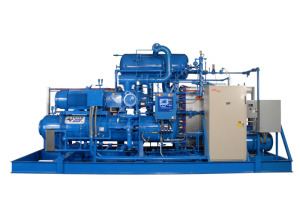Back in the 1960's, Emerson was known for its radios marketed to individuals. It has since reduced this business and now markets products and services to industry. Photo: Flickr.com/Joe Haupt
About Emerson

One of Emerson’s brands is Vilter Manufacturing, which produces compressors for industrial refrigeration and gas compression applications.
Photo from Emerson Climate’s website.
Emerson is a diversified manufacturing and technology company that provides electrical and other products for the industrial, commercial and consumer markets worldwide. The company has 115,000 employees and 220 manufacturing locations worldwide.
Emerson’s businesses are divided into 5 segments:
- Emerson Process Management produces a variety of valves, regulators and sensors for the energy, chemical, life sciences, metals & mining, and waste industries.
- Emerson Industrial Automation produces electrical generation and transmission products, and electrical motors for the energy, automobile, food and metals industries.
- The Emerson Network Power segment produces Uninterruptable Power Systems (UPSs), thermal management systems and integrated computer racks for computer and network businesses.
- The Emerson Climate Technologies segment produces thermostats, air conditioning drives, ceiling fans, motors, valves and compressors for the commercial and residential markets.
- The Emerson Commercial & Residential Solutions segment produces food waste disposals, instant hot water dispensers and tools for the residential and commercial markets.
Charles and Alexander Meston, who saw a business opportunity in developing a reliable electric motor, formed the Emerson Electric Manufacturing Company in 1890. The company was named after the Meston’s financial backer and the first company president, John Wesley Emerson. In 1892, as sales approached $60,000, Emerson manufactured the first electric fans to be sold in North America. As more and more American homes were wired for electric power Emerson grew quickly, with net sales hitting nearly $3 million in 1919. Along the way, the company introduced its ceiling fan to the residential market.
Emerson struggled during the Great Depression, moving first to the mass production of electric motors and a variety of consumer fans, and winning a contract to build arc welders. During World War II, Emerson produced airplane gun turrets and brass shell casings for the U. S. Army Ordinance Department. Following World War II and the Korean War, Emerson began a period of rapid growth, diversifying into high-growth markets through acquisitions. From 1954 to 1973, the company grew from 4,000 employees and $56 million in sales to 31,000 employees and $800 million in sales. Acquisitions during this time included InSinkErator, Therm-O-Disc and toolmakers Ridge Tool and White-Rodgers.
Building on this success, Emerson continued to acquire other companies, buying instrumentation manufacturer Rosemount in 1976, compressor manufacturer Copeland in 1986, UPS manufacturer Liebert in 1987, and process control valve and regulator company Fisher Controls in 1992. By 2000, sales had surpassed $15 billion and the company decided to shorten its name to “Emerson”. In 2001, the company made two moves in the Asian market: the acquisition of Avansys, China’s leading network power provider, and the formation of Emerson Network Power India Private Ltd. Emerson’s international sales exceeded U.S. sales for the first time in 2007.
The company is a member of the S&P 500 index and trades under the ticker symbol EMR.
Emerson’s Dividend and Stock Split History
Emerson first began increasing dividends in 1957 and met the Dividend Aristocrat criteria of 25 consecutive years of increasing regular dividend payments in 1981. Emerson announces its annual dividend increase in November; the stock goes ex-dividend later in the month.
Emerson has compounded its payout at an average rate of 3.6% over the last 5 years and 5.9% over the last 10 years.
Since meeting the Dividend Aristocrat criteria of 25 consecutive years of dividend growth in 1981, Emerson has split its stock three times: a 3-for-1 stock split in August 1987, a 2-for-1 stock split in February 1997 and, most recently, a 2-for-1 stock split in November 2006. You would now have 12 shares of Emerson stock for each share that you purchased at the beginning of 1981. Prior to becoming a Dividend Aristocrat, Emerson conducted four 2-for-1 stock splits in January 1960, January 1962, February 1969, and August 1973.
Emerson’s Direct Purchase and Dividend Reinvestment Plans
Emerson has both direct purchase and dividend reinvestment plans. Investors interested in participating in either of these plans can find information at the ComputerShare Investment Plan site. The dividend reinvestment plan allows you to reinvest dividends in full or in part; you can also choose to have the dividends directly deposited into your checking account.
You’ll pay a $15 initial set up fee when first investing in the dividend reinvestment plan. For new investors, the minimum purchase is $250, either in a single purchase or 10 monthly purchases of $25 each. Subsequent purchases require a minimum investment of $25. You won’t pay a charge when directly purchasing shares by check or automatic debit, and Emerson covers the transaction and per share fees associated with reinvesting dividends.
When you sell your shares in the plan, you’ll pay a transaction fee of 12 cents per share sold plus a transaction fee of between $15 and $25, depending on the type of sell order. If you sell your shares by phone with the help of a customer service representative, you’ll pay an additional $15 fee.
Helpful Links
Emerson’s Investor Relations Website
Current quote and financial summary for Emerson (finviz.com)
Information on the direct purchase and dividend reinvestment plans for EMR
